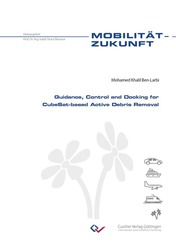| Departments | |
|---|---|
| Book Series (96) |
1379
|
| Nachhaltigkeit |
3
|
| Gesundheitswesen |
1
|
| Humanities |
2367
|
| Natural Sciences |
5407
|
| Engineering |
1793
|
| Engineering | 292 |
| Mechanical and process engineering | 862 |
| Electrical engineering | 686 |
| Mining and metallurgy | 30 |
| Architecture and civil engineering | 75 |
| Common |
98
|
|
Leitlinien Unfallchirurgie
5. Auflage bestellen |
|
Advanced Search
Guidance, Control and Docking for CubeSat-based Active Debris Removal (Volume 38) (English shop)
Mohamed Khalil Ben-Larbi (Author)Preview
Extract, PDF (730 KB)
Table of Contents, PDF (42 KB)
While a paradigm shift in space industry has already started involving “mass production” of higher standardized, large distributed systems such as constellations, there are no effective solutions existing for the “mass removal” of satellites. Many indicators point to a further increase in the space traffic in Earth orbit in the near future, which could imply new dynamics in the evolution of the space debris environment. Even in case of diligent compliance with the Inter-Agency Space Debris Coordination Committee (IADC) mitigation guidelines, the growth in space traffic complicates its management and drastically increases the probability of accidents and system failures. NASA scientist Donald J. Kessler proposed a scenario in which the density of objects in low Earth orbit is high enough that collisions between objects could cause a cascade that renders space unusable for many generations. Therefore, a reliable and affordable capability of removing or servicing non-functional objects is essential to guarantee sustainable access to Earth orbit. Recently, the CubeSat design standard introduced a new class of cost-efficient small spacecraft and thereby offers a potential solution to the active debris removal (ADR) problem. The development of a novel “CubeSat-compatible” ADR technology has significant advantages such as the use of commercial off-the-shelf parts, reduced launch cost, and reduced design efforts.
This thesis presents –in the frame of an ADR mission– an approach to advanced rendezvous and docking with non-cooperative targets via CubeSat. It covers the design process of simulation systems used for verification purposes, the ideation and implementation of novel guidance, control, and docking techniques, as well as their verification and evaluation. The outcome of this research is a series of validated software tools, processes, technical devices, and algorithms for automated approach and docking, that have been tested in simulation and with prototype hardware.
| ISBN-13 (Hard Copy) | 9783736978485 |
| ISBN-13 (eBook) | 9783736968486 |
| Final Book Format | B5 |
| Language | English |
| Page Number | 222 |
| Edition | 1. |
| Book Series | Mobilität - Zukunft |
| Volume | 38 |
| Publication Place | Göttingen |
| Publication Date | 2023-08-07 |
| General Categorization | Dissertation |
| Departments |
Engineering
Mechanical and process engineering |
| Keywords | CubeSat (CubeSat), Space debris (Weltraummüll), Active debris removal (Aktive Weltraummüllentfernung) (ADR), Docking (Docking),Guidance and control (Steuerung (oder Führung) und Regelung), Rendezvous (Rendezvous), Rendezvous and docking (Rendezvous und Docking), Non-cooperative target (Nicht kooperatives Ziel), Small satellite (Kleinsatellit), Space debris priority list (Weltraummüll Prioritätsliste), Kessler syndrome (Kessler Syndrom), Formation fight (Formationsflug), Guidance, navigation, and control (Steuerung (oder Führung), Navigation und Regelung) (GNC), Concept of operations (Betriebskonzept), Spacecraft relative motion (Relative Bewegng von Raumfahrzeugen), Relative orbital elements (Relative Orbitalelemente), Systems engineering (Systemtechnik), Modeling and simulation (Modellierung und Simulation), Model-based systems engineering (Model-basierte Systemtechnik), Verification and Validation (Verifikation und Validierung), Hardware-in-the-loop simulation (Hardware-in-the-Loop Simulation), Astrobee (Astrobee), International Space Station (Internationale Raumstation), Air bearing table (Luftlagertisch), ELISSA (ELISSA), Free flyer (Free flyer), Aeromechanical platform (Aeromechanische Plattform), Low Thrust (Niedriger Schub), Impulsive thrust maneuver (Imulsive Schubmanöver), Finite duration maneuver (Schubmanöver mit endlicher Dauer), Control Accuracy (Regelgüte), Input-output Linearization (Eingang/Ausgang Linearisierung), Feedback Linearization (Globale Linearisierung), Differential Drag (Differentieller Atmosphärischer Widerstand), Controllability (Steuerbarkeit), Gecko materials (Gecko Materialien), Dry adhesives (Trockene Adhäsiva), Micropatterned dry adhesives (Mikrohaftstrukturen), Docking mechanism (Dockingmechanismus), Astronaut (Astronaut), Victor Glover, Shannon Walker |








